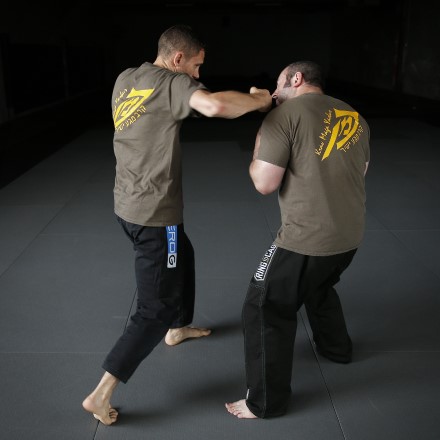Krav Maga Striking

Striking Articles
- The Power Behind The Punch
- Principle 6 - Power Punching
- Combatives & The Combative Mindset
- Punching Problems - Fixing Common Errors (Part 1)
- Punching Problems - Fixing Common Errors (Part 2)
- Knockout Strikes, Continued Assaults & Killing Grounds
- Preemptive Striking
- The Myth Of The Krav Maga Groin Strike
- The Myth of Striking
- The Illusion Of Speed
- Telegraphing
- Hammer-fists and Forearm Strikes
- Using Your Head
- 5 Methods For Dealing With Strikes
- Body Shots
- Accuracy & Power
- Roundhouse Kicks
- Hook Punches
- Landing The First Strike
- Increasing the Power of the Jab
- Lessons In Striking
- Fighting A Southpaw
- Liver Shots
- Striking Rhythms
- Palm Strikes Or Punches
- Power Slaps
- Trebuchets & Roundhouse Kicks
All Krav Maga Articles
Krav Maga's Use Of Striking
Krav Maga is predominantly a striking system, that aims to use punches, elbows, knees, kicks, and headbutts etc., to overwhelm an attacker, in order to create either an opportunity to disengage, or end the fight using concussive force. One of the defining features of Krav Maga is the use of continued pressure, usually through striking combinations, to prevent an assailant from being able to mount their own attack or assault e.g., using offense as defense etc. This may also mean pre-emptively launching a striking barrage, rather than waiting for an assailant to strike/punch first etc. Pre-emptive striking is legally permitted as long as the conditions for “Assault” have been met i.e., a person believes they are at risk of physical harm from another, and that their aggressor is in a position to commit “Battery” (unwanted touching), that is they are close enough to make physical contact; touch them. In many cases, striking first as a preemptive strategy, is better survival strategy than waiting to react and respond to an assailant’s own attack. By making the first strike, and following it up with constant, and continuous pressure it may be that an aggressor never even gets a chance to make their own attack and has to behave in a totally defensive manner e.g., striking can be looked on as a Zero-Sum activity: if one person isn’t striking, the other is.
Striking can take the form of distracting blows, aimed at disrupting an attacker’s movement and assault, as well as power strikes that deliver concussive force etc. It should bee noted that most fights don’t end because the other party is physically incapable of continuing the confrontation, because they are unconscious or injured etc., but because they have psychologically and mentally crumbled in response to feeling overwhelmed by the other person’s aggression and violence. Most people are not psychologically prepared to deal with being punched, hit and/or kicked, and so when this happens, they are unable to cope because they are not sure how to respond/fight back. If they have never thrown a punch in their life or the last time, they did was in a school yard fight etc. they are unlikely to be able to act offensively and are simply forced to cover and protect themselves as best they can; this is also true for aggressive individuals who start confrontations, and unintentionally commit Assault, without realizing so, prompting the other person to start responding physically etc. Not everybody who “starts” a fight, knows how to fight.
Krav Maga makes use of almost every part of the body as a weapon that can be used to strike with, and as a system looks to be able to deliver strikes at all levels (punches to the head, kicks to the lower body etc.), and from all angles, such as straight punches, hook punches and uppercuts etc. The goal being to overwhelm an assailant, making them feel as if there is no part of their body is safe from attack and experiencing pain etc. The purpose of this is not to punish or teach a person a lesson etc. but to take the fight out of them in order to create a safe disengagement opportunity. To be able to make a claim of self-defense and not be guilty of using excessive force, the best strategy you can adopt is exciting the fight and clearing the location (safely) at the earliest opportunity.